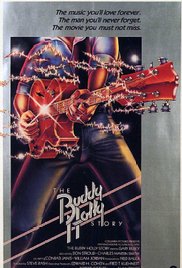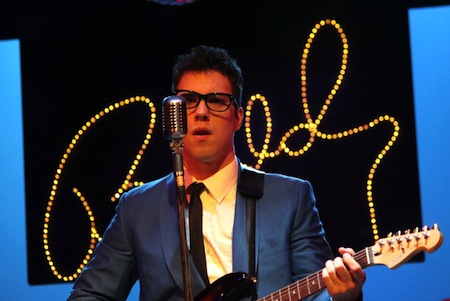THE BUDDY HOLLY STORY
SUBJECTS — Biography; Music/Popular; U.S./1945 -1991;
SOCIAL-EMOTIONAL LEARNING — Talent;
MORAL-ETHICAL EMPHASIS — General.
AGE: 12+; MPAA Rating — PG;
Drama; 1978; 113 minutes; Color. Available from Amazon.com.
There is NO AI content on this website. All content on TeachWithMovies.org has been written by human beings.

SUBJECTS — Biography; Music/Popular; U.S./1945 -1991;
SOCIAL-EMOTIONAL LEARNING — Talent;
MORAL-ETHICAL EMPHASIS — General.
AGE: 12+; MPAA Rating — PG;
Drama; 1978; 113 minutes; Color. Available from Amazon.com.
This is a biography of Buddy Holly, one of the pioneers of modern rock and roll.
Selected Awards: 1978 Academy Awards: Best Adapted Score; 1978 National Society of Film Critics Awards: Best Actor (Busey); 1978 Academy Award Nominations: Best Actor (Busey), Best Sound; 1979 Golden Globe Awards Nominations: Best Actor (Busey).
Featured Actors: Gary Busey, Don Stroud, Charles Martin Smith, Conrad Janis, William Jordan, Maria Richwine, Albert Popwell, and Amy Johnston.
Director: Steve Rash.
Around the time that your child watches this movie, play some of Buddy Holly’s music and tell your child what it is. Ask and answer the Quick Discussion Question and if your child knows who “The Beatles” are, describe how they chose their name. See the Helpful Background section. If your child is very interested in the film, go through some of the other Discussion Questions.

Buddy Holly (1938 – 1959) died in a plane crash at the age of 22. During his brief career, Buddy Holly helped define rock and roll music. At the time of his death, Buddy Holly’s popularity rivaled that of Elvis Presley. His hits included “That’ll Be the Day” and “Peggy Sue.” Buddy Holly’s music was very influential in Europe. “The Beatles” took their name as a parody of and tribute to Buddy Holly’s band “The Crickets.”
Rock and roll developed from the blues, hillbilly, boogie-woogie, rhythm and blues, bluegrass and country western.
The importance of Buddy Holly and “The Crickets” is underlined by the fact that “The Beatles” took their name as a parody of and tribute to Buddy Holly’s band “The Crickets.”
The “Ed Sullivan Show” was the most popular variety show on television running from 1948 to 1971. It featured a wide range of acts from acrobats to opera singers. Sullivan had the knack of attracting to his show most of the up-and-coming talent in the entertainment world. The “Ed Sullivan Show” had a strong influence on America’s tastes, and watching it was a Sunday night ritual for millions of Americans.
Why was there a moment of tension when Buddy Holly and The Crickets were introduced to the black audience at the Apollo Theater? Why were they so well received by that same audience when they began to play?
Suggested Response:
No white band had ever played the music that the audience at the Apollo had come to hear. When the Crickets began to play, the audience understood that they were hearing something very new; not so much in terms of what was being played (although that was new, too), but because a white band was playing music that borrowed heavily and well from the styles that they were previously thought of as being music performed by black people.
1. See Discussion Questions for Use With any Film that is a Work of Fiction.
2. What are some of the musical styles that were combined to form rock and roll?
Suggested Response:
Blues, hillbilly, boogie-woogie, rhythm and blues, bluegrass, and country western.
3. How did “The Beatles” get their name, and what does it have to do with Buddy Holly?
Suggested Response:
“The Beatles” took their name as a parody of and tribute to Buddy Holly’s band “The Crickets.”
1. What obstacles did Buddy Holly have to overcome to permit him to show his talent?
Suggested Response:
He had to get white people to listen to music with a heavy component of what had previously been thought of as music styles of black people (blues, boogie-woogie, and rhythm and blues). He also had to get black people to listen to white people playing this music.
2. What did Buddy Holly contribute to American society?
Suggested Response:
He was one of the originators of a new kind of music that has enriched our culture.
Discussion Questions Relating to Ethical Issues will facilitate the use of this film to teach ethical principles and critical viewing. For convenience, the Six Pillars of Character are set out below.
(Be honest; Don’t deceive, cheat or steal; Be reliable — do what you say you’ll do; Have the courage to do the right thing; Build a good reputation; Be loyal — stand by your family, friends and country)
(Treat others with respect; follow the Golden Rule; Be tolerant of differences; Use good manners, not bad language; Be considerate of the feelings of others; Don’t threaten, hit or hurt anyone; Deal peacefully with anger, insults, and disagreements)
(Do what you are supposed to do; Persevere: keep on trying!; Always do your best; Use self-control; Be self-disciplined; Think before you act — consider the consequences; Be accountable for your choices)
(Play by the rules; Take turns and share; Be open-minded; listen to others; Don’t take advantage of others; Don’t blame others carelessly)
(Be kind; Be compassionate and show you care; Express gratitude; Forgive others; Help people in need)
(Do your share to make your school and community better; Cooperate; Stay informed; vote; Be a good neighbor; Obey laws and rules; Respect authority; Protect the environment)